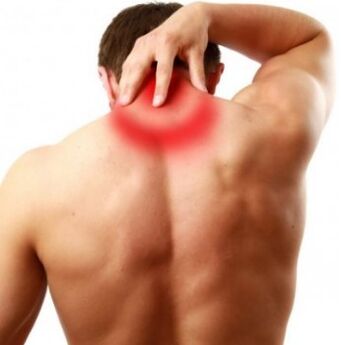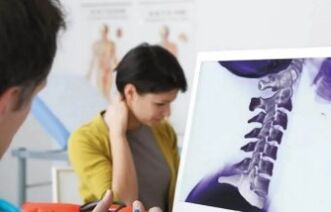Osteochondrosis is an illness of the spine, characterized by the development of changes in the cartilage of intervertebral disks and jet processes in the surrounding tissues.
Cervical osteocondrosis waistIt differs from the manifestations of the thoracic and waist osteocondrosis.The symptoms of cervical osteocondrosis are associated with the anatomical features of cervical spine.The sizes of the cervical region are less than the size of other departments.The cervical department is constantly experiencing an download, holds his head and at the same time very mobility.

Reasons for osteocondrosis
The causes of the development of the disease are primarily due to the development of age and bone and cartilage in which the body is aged.The following reasons for osteocondrosis can be called:
- Violation of the posture,
- Reducing motor activity as a result of a sedentary lifestyle,
- There is a load on excessive weight, intervertebral disks, the result of metabolic disorders,
- hereditary factor,
- Long - physical activity,
- the abnormalities of the spine.
A single physical activity, proper nutrition and a healthy lifestyle significantly reduces the likelihood of developing this disease and also reduces the impact of the total well.
Symptoms of cervical spine osteocondrosis
The manifestations of cervical osteochondrosis are different from the symptoms of the other spine.This is because of the fact that cervical vertebrae have a different structure and very close.Therefore, any displacement shows itself with severe pain.In addition, the nervous package and arteries are often squeezed in cervical spine.
Cervical osteocondrosis of the spineItself shows itself with the following symptoms:
- Pain feelings - pain can be felt in different parts of the body.This is due to the nervous ends and the muscles of the relevant part of the body.
- Weakness in the upper limbs - shows itself due to the bathing of nervous ends in charge of motor activities.
- Difficulties in the cervical region, the emergence of a crisis in the Vertabra in the cervical region is due to changes in the intervertebral disk structure, the appearance of bone formation.
- Low sensitivity of hands.
- Weakness and dizziness appears due to the bathing of the artery that provides blood and nutrition in the brain.
- Hearing and vision reduction - appears in the final stage of the disease when the blood circulation in Cerebellum is broken.
Signs of the cervical department of osteocondrosis
- Rin syndrome - characterized by a pinch of the nerve beam in the neck.Shows herself with severe pain that can be felt in the shoulders.
- Vertebrate syndrome - the strongest headache, pain in the temples and the pain behind the head.
- Reflex syndrome is characterized by severe pain in the cervical region that can be strengthened with any head movement.The pain can move on the shoulder and chest.
- Cardinal syndrome - looks like an attack on the angina pector, which is very difficult to determine.
Development rate of cervical spine osteocondrosis
As developed, the disease passes several stages.Each stage has its own characteristics and is characterized by certain features.
- Stage 1.Vertebrebree Bone-Xrizny texture is gradually begins to collapse.Symptoms of the disease are noticeable.And often the patients do not simply see them, but their fatigue and pain associate with extreme work and stress.
- Stage 2. Boyda, the disc begins to decrease, cracks appear.The patient experiences continuous pain, weakness, face numbness.
- Step 3. Dropped discs begin to form, cervical veins and muscles are damaged.Dizziness, there are complaints about the pain behind the head.
- Stage 4.The bone texture that protects vertebrebre from loads, as a result, the nerve ends are squeezed.There is stiffness in the actions, neighboring joints were damaged.
Dangers of cervical osteocondrosis
A large number of nerves and vascular brains are in the cervical region.When you break their work, the brain will not receive enough nutrition for normal operation.This situation may disrupt a person's motor activity, cause pain in limbs, as well as a loss of coordination.
In a developed stage of osteocondrosis, ischemia, which is dangerous for human life, can develop and develop many other diseases.
Therefore, when any symptom associated with this disease is recommended to seek medical care.
Cervical waist diagnosis
The following types of diagnostics are used to explore spinal diseases:
- X -ray picture is an inefficient way to diagnose this disease,
- MRI (magnetic resonance image) shows bone structures, formed disk corners and sizes,
- CT (calculated tomography) is ineffective compared to MRI because it is difficult to determine the size of the tears with the help of diagnostic methods,
- Ultrasound duplex scan is used when the general blood flow is broken.This examination also shows the current speed of blood flow, as well as obstacles in the road.
Treatment of cervical spine osteocondrosis

The treatment of cervical osteochondrosis should be carried out in the complex depending on the situation.Drug treatment, procedure, physiotherapy exercises, massio and traditional medicine can have a positive effect thanks to a comprehensive and individual approach to the physical, massage and traditional medicine.
During the development of the spine, cervical osteochondrosis was aimed at the increase in the blood circulation in escalating muscle cramps.In this case, agents, anti-inflammatory and painkillers and vitamin complex, which improve blood flow.
Media physical education for osteocondrosis of the cervical region
Therapeutic gymnastics gives visible results and is less dangerous in the restoration stage.The principle of physiotherapy exercises is to restore blood flow in the damaged parts of the body.Implementation of physiotherapy exercises should not feel sick pain and anxiety.
The king of the training for cervical spine is designed to strengthen neck muscles and plays the role of cervical osteocondrosis.
Massage for the cervical waist osteocondrosis
The massage is carried out to strengthen the tone in the muscle and eliminate the pain.Different massage methods are made depending on the development phase of the disease.Classic massage techniques include:
- Stroking - This technique affects the surface of the skin.The massage collar begins with the area and the claves and armpits continue.
- Squeeze - in this case, the effects of the massage occurs in the deeper layers of the skin.Bury your neck with your thumb with a thumb and perform the actions to move to squeeze the skin.
- To rub - is carried out in order to warm and relax the skin to improve the blood supply in the cervical waist collar.
- Kneading - has special restrictions, because it affects deep false pieces.If this method is wrong, the patient may be harmful.
When the patient's sense of pain occurs only on one side, the massage must start with the health of a healthy part of the cervical region, which the pain appears.
Massage can be carried out both at home and at a medical facility.However, you must be very careful not to exacerbate the disease during the implementation.
Prevention of cervical osteochondrosis
Recommended to follow simple rules to prevent the formation and development of the disease:
- Take a healthy lifestyle, do physical exercise, regularly visit the pool;
- Diversify the diet of foods rich in magnesium and calcium;
- In the case of sysarent work, it should be warmed several times a day;
- You have to choose an orthopedic mattress and a comfortable pillow for sleep.






















